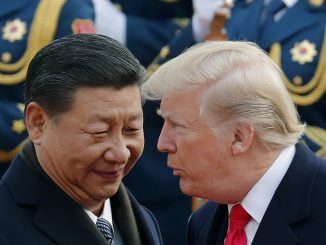
GENEVA — The United States and China agreed Monday to slash their massive recent tariffs, restarting stalled trade between the world’s two biggest economies and setting off a rally in global financial markets.
But the de-escalation in President Donald Trump’s trade wars did nothing to resolve underlying differences between Beijing and Washington. The deal lasts 90 days, creating time for U.S. and Chinese negotiators to reach a more substantive agreement. But the pause also leaves tariffs higher than before Trump started ramping them up last month. And businesses and investors must contend with uncertainty about whether the truce will last.
U.S. Trade Representative Jamieson Greer said the U.S. agreed to drop the 145% tax Trump imposed last month to 30%. China agreed to lower its tariff rate on U.S. goods to 10% from 125%.
A deal averts a total blockade
Greer and Treasury Secretary Scott Bessent announced the tariff reductions at a news conference in Geneva.
The officials struck a positive tone as they said the two sides had set up consultations to continue discussing their trade issues. Bessent said that the triple-digit tariffs the two countries imposed on each other last month — in an escalation of tensions Trump started — amounted to “the equivalent of an embargo, and neither side wants that. We do want trade.”
The delegations, escorted around town and guarded by scores of Swiss police, met for at least a dozen hours on both days of the weekend at a sunbaked 18th-century villa that serves as the official residence of the Swiss ambassador to the United Nations in Geneva.
At times, the delegation leaders broke away from their staffs and settled into sofas on the villa’s patios overlooking Lake Geneva, helping deepen personal ties in the effort to reach a much-sought deal.
Finally, a deal
The 30% levy that America is now imposing on Chinese goods includes an existing 20% tariff intended to pressure China into doing more to prevent the synthetic opioid fentanyl from entering the United States. It also includes the same 10% “baseline” tariff Trump has slapped on imports from most of the world’s countries. The 30% tax comes on top of other levies on China, including some left over from Trump’s first term and kept by former President Joe Biden.
Trump had ratcheted the combined tariff to 145% last month, furious that China was retaliating, before backing down Monday.
China’s Commerce Ministry called the agreement an important step for the resolution of the two countries’ differences and said it lays the foundation for further cooperation.
“This initiative aligns with the expectations of producers and consumers in both countries and serves the interests of both nations as well as the common interests of the world,” a ministry statement said.
China hopes the U.S. will stop “the erroneous practice of unilateral tariff hikes” and work with China to safeguard the development of economic and trade relations, injecting more certainty and stability into the global economy, the ministry said.
Markets rally as two sides de-escalate
The full impact on the complicated tariffs and other trade penalties enacted by Washington and Beijing remains unclear. And much depends on whether they will find ways to bridge longstanding differences during the 90-day suspension.
Bessent said in an interview with CNBC that U.S. and Chinese officials will meet again in a few weeks.
But investors rejoiced as trade envoys from the world’s two biggest economies blinked.
Futures for the S&P 500 jumped 2.6% and the Dow Jones Industrial Average was up 2%. Oil prices surged more than $1.60 a barrel, and the dollar gained against the euro and the Japanese yen.
“This is a substantial de-escalation,” said Mark Williams, chief Asia economist at Capital Economics. But he warned “there is no guarantee that the 90-day truce will give way to a lasting ceasefire.”
Craig Singleton, senior director of the China program at the Foundation for Defense of Democracies, said the speed at which the agreement came about suggested that “both sides were more economically boxed in than they let on.”
“For China, the economic pain was real: Rising unemployment, capital flight, and export orders falling at their fastest rate in nearly two years,” Singleton said. “For Trump, markets mattered, and this deal gives him a win without abandoning leverage.”
The announcement by the U.S. and China sent shares surging, with U.S. futures jumping more than 2%. Hong Kong’s Hang Seng index surged nearly 3%, and benchmarks in Germany and France were both up 0.7%



